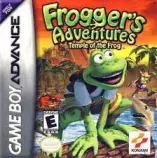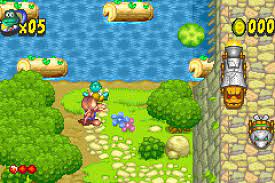Frogger's Adventure: Temple of the Frog - A Bizarre Reinvention
4/09/23

When you think of the ‘true classics’ of the video game medium, you think of titles like Pong, Pac-Man, Space Invaders. Another game I’d consider along those lines is Frogger, the classic car-avoiding simulator. What sets it apart from those earlier examples is I think Frogger has fallen out of the general popular knowledge base - I mean, everyone knows Pong and Pac-Man, but how many kids know what the hell Frogger is? Anyway, things were different back in 2001 - Frogger was a bonafide classic, but just porting over the arcade original wasn’t enough; we got a genuine paradigm shift for the little, uh, Frogger, turning the back-and-forth series into an actual adventuring platform, maintaining the original’s brutal difficulty whilst not totally ignoring the path the series tread before it’s reinvention, culminating in a title that whilst didn’t blow me away, was still satisfying to complete in it’s own right.
I’ll be honest, when I first read the title ‘Frogger’s Adventure: Temple of the Frog’, I almost pissed myself - why the hell does Frogger need a full make-over!? Just give us the arcade game or, I dunno, leave him alone. Either way, after the nightmare of writing my Yggdra Union review, I picked up Frogger because it was a. Hilarious that this exists and b. It seemed like a short, albeit challenging time. I was correct on both these fronts, making this the perfect game to cool down, even just a little bit. And I just had to see - why does this game exist? Is it Frogger just in name? Will this game make me bash my skull in? Well, I didn’t do the latter, but I suppose the other two questions are still a bit up in the air, so let’s just dive (hop? Damn it.) in and see what Frogger’s Adventure: Temple of the Frog is!
So, you remember how Frogger played (I hope I’m not dating myself here) - top-down, crossing moving platforms over a river and avoiding oncoming traffic and creatures and all that. To my amazement, Temple of the Frog is an actual, adventure-styled evolution of that basic framework. Across five worlds, each consisting of three unique levels; obstacles can range from creatures moving back and forth in regular patterns, navigating across flying platforms, or timing your hops between spiked platforms that raise and lower in regular patterns. Much like the original, this is a game of timing; identifying patterns of moving platforms and patrolling enemies, and identifying a path that’ll push you through unscathed. The complexity of these combinations grow as the game goes on - platforms and enemies will become ‘unsynced’ from each other, giving your avenues for moving forward smaller and smaller windows, or you’ll be dealing with multiples all at once; one of the hardest sections of the games I dealt with was a set of reverse moving platforms, which you have to time jumps between as you move forward as waves of spikes are fired down the way in alternating patterns. It requires a lot of focus and brainpower to push through, but the feeling of clearing these trials are euphoric in nature.

Controls are for the most part pretty tight, and there’s a certain satisfaction in having Frogger bounce about, no matter if it’s just leaping down a straight line of tiles or you’re dodging and weaving between foes and traps alike. The only real caveat is that there are dedicated buttons to turn around - the shoulders buttons, that is - and some of the hardest sequences in the game will require you to use this in concert with your general movement skills, and I can say a good half of my non-boss fight deaths are probably doing to how unintuitive it is to stop and turn, rather then hitting the button to move and plunging to my death because I assumed he’d turn. I said turn, far, far too many times in that sub-paragraph, geez.
There are a few collectibles you’ll also have to take into mind. Each zone has elemental orbs to collect - three in a zone’s first stage, and five in the second - that are required to progress forward. Once or twice I’d miss one of the orbs on a stage, usually because of an alternate path not jumping out to me (or, more likely, I’m an idiot), but for the most part these are pretty easy to locate. The other collectible is coins - just your normal, bread-and-butter currency. Y’see, these coins are used in moment-to-moment gameplay, but between stages you’ll be constantly reminded that you’ll need fifty coins - total - to even access the Temple of the Frog. This is a bizarre stipulation, considering that these levels are packed to the rafters with coins, and you don’t even lose them when you have to use a Continue. I genuinely can’t think of a reason they added this to the game; if a kid has managed to barrel their way through this challenging title, I’d say there is no doubt they’d have gotten the requisite amount of coins. I dunno, it just throws me off.
Whilst it is impressive that these levels are a cool way to level-up Frogger’s base gameplay, I wouldn’t say these levels are anything to write home about. There’s also an element of the game sometimes getting you killed without your input; more than a few times I’d slip from a platform I *knew* I’d landed on, or I’d be spiked or poked by an enemy that didn’t even make contact with me. It’s a brutal game - not quite on the level of NES-era Nintendo games, but even with its short length, it took me about two hours to beat Temple of the Frog, and I can say with certainty I can’t imagine any child actually managing to get through this game. It’s fun, yeah, but some of the obstacle combinations they throw at you in the final stages are genuinely wacky. I also had one complete soft-lock after defeating Mr. D’s first form, where Frogger decided he really wanted to shove his face into the left-side wall instead of actually exiting the room, but that was the only actual bug I suffered through my two hours in Temple of the Frog.
Each zone culminates in a boss fight, which to its benefit are less traditional affairs and are more platform/puzzle encounters. For example, the first boss can only be defeated by activating switches in a certain order, whilst avoiding fireballs and spike traps. They all essentially fall under this kind of an encounter, aiming to hit switches or toggle nodes to indirectly bring down the bosses. These puzzle-styled fights are way more interesting then just giving Frogger pointless combat mechanics just for the purpose of the fight, and Some of these fights - especially Mr. D, who probably took me down thirty times - can be kind of brutal, but thankfully the game’s genuinely conservative Continue mechanic will thankfully keep you from having to repeat the already challenging stages. Still, occasionally these fights can be a bit more frustrating than they’re worth, with certain moves and attacks pushing you into corners that give you no escape, but these are thankfully few and far between.

There’s not much story to speak of, outside a few lines of dialogue, which are universally hilarious in the context that this is a goddamn Frogger game. A weird skeleton guy named Mr. D has taken over Frogger’s race of… of frogs Temple of the Frog, and so Frogger is sent on a adventure to regain the powers of the elements (for some reason) and to liberate the Temple of the Frog from Mr. D. It’s all just a framing device, but pretty much every line of dialouge is enhanced by the fact that it’s just fucking Frogger and his friends saying it. There’s this whole moment where Frogger goes to a flying temple, meets a fairy, and in the ending, the fairy randomly says that only Frogger can see it, leading to his friends thinking he’s a loon. And they’re just constantly reinforcing the basic things you need to do - find the elemental orbs and fifty coins - it’s almost hilarious.
Finally, considering this was one of the earliest GBA titles to come out, this game actually looks pretty nice, albeit having a generally simple art direction. At least when it’s from the normal gameplay perspective… some of these character art is kind of… I don’t want to say *bad*, but I do want to say *kind of terrifying*. Seriously, in the efforts of making Frogger look like a marketable character, they made him look kind of awful. Seriously, look at that box art. Anyway, the game does a good job of creating distinct zones and biomes for Frogger to move through, and a bunch of the earlier stage layouts really felt like I was playing an evolved version of Frogger, which is pretty cool to see. Soundtracks’ not too bad either, having a real low-key, bassy tune that doesn’t quite capture the vibe of the madness of what this game turned out to be, but yeah, it’s fine.
Whilst Frogger: The Temple of the Frog isn’t going to set any houses on fire, it is a perfectly serviceable puzzle-platformer that somehow works as an evolution of the classic arcade game. Whilst its occasionally brutal difficulty can bloom frustration, this is otherwise a fun, albeit truncated, straightforward title that is worth a play for those - for whatever reason - are interested in the evolution of the storied franchise of, uh, Frogger. Seriously, why did Frogger need a character rebrand? The year was 2001, I feel like most people picking up a GBA in its first year weren’t particularly enamored with the character - but I digress; this game’s all right.
Thank you so much for reading my review of Frogger’s Adventure: Temple of the Frog! This was a nice, easy little review to do in the wake of a couple of the couple of bigger games I’ve played in the last month or so. Anyway, I expect the new few weeks worth of games to be pretty chill; next week is a game I’ve literally never heard of, and I’d bet good money on the majority of people who’ve been reading this website for the last year and a half (and holy shit, it’s been a year and a half!?) will have heard of it, either. Anyway, as always you can email me at mgeorge7003@hotmail.com or cckaiju@gmail.com if you have any requests or questions. But for now, thanks again for reading, and I’ll see you in my next review!
